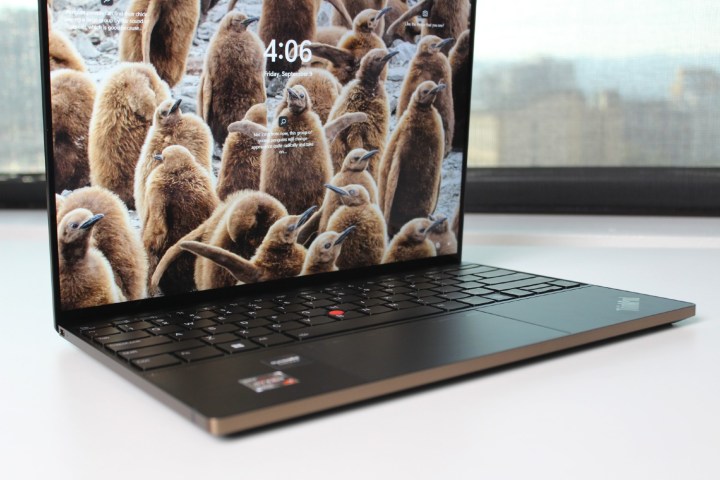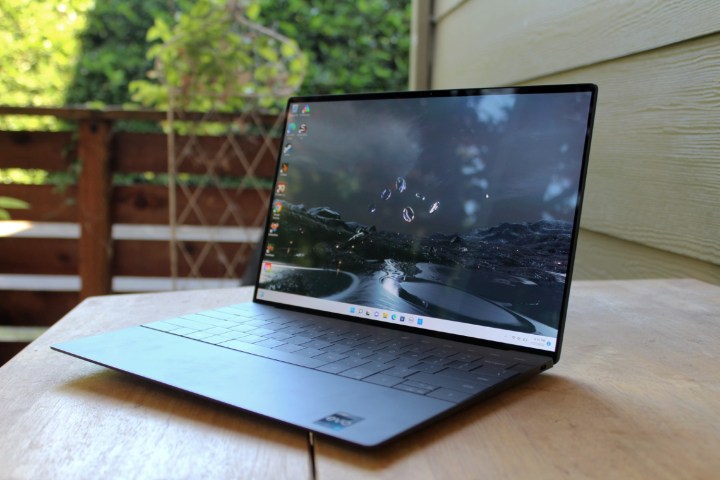Many manufacturers are switching to 14-inch laptops, but that doesn’t mean the 13-inch laptop is going away anytime soon. Dell has its excellent XPS 13 Plus and Lenovo recently introduced the ThinkPad Z13, proving that 13-inch machines still have their place.
It’s a strong competition between these two excellent laptops, both of which represent upgraded and/or diverging designs. One has to win, though, so read on to find out which is the better diminutive laptop.
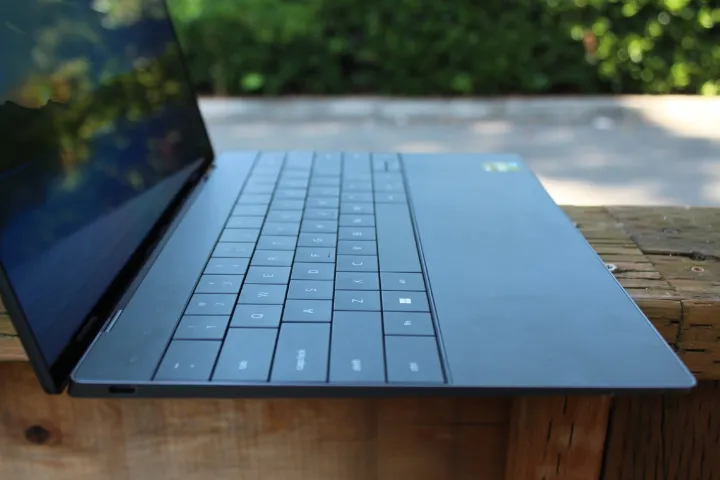
Specs and configurations
| Lenovo ThinkPad Z13 | Dell XPS 13 Plus | |
| Dimensions | 11.6 inches x 7.9 inches x 0.55 inches | 11.63 inches by 7.84 inches by 0.60 inches |
| Weight | 2.76 pounds | 2.71 pounds |
| Processor | AMD Ryzen 5 PRO 6650U AMD Ryzen 7 PRO 6850U AMD Ryzen 7 PRO 6860U |
Intel Core i5-1240P Intel Core i7-1260P Intel Core i7-1280P |
| Graphics | AMD Radeon graphics | Intel Iris Xe graphics |
| RAM | 16GB 32GB |
8GB 16GB 32GB |
| Display | 13.3-inch 16:10 IPS Full HD+ (1,920 x 1,200) 13.3-inch 16:10 IPS Full HD+ (1,920 x 1,200) touch 13.3-inch 16:10 OLED 2.8K (2,880 x 1,800) touch |
13.4-inch 16:10 IPS Full HD+ (1,920 x 1,200) non-touch 13.4-inch 16:10 IPS Full HD+ touch 13.4-inch 16:10 OLED 3.5K (3,456 x 2,160) touch 13.4-inch 16:10 IPS UHD+ (3,840 x 2,400) touch |
| Storage | 256GB SSD 512GB SSD 1TB SSD |
512GB SSD 1TB SSD 2GB SSD |
| touch | Optional | Optional |
| Ports | 2 x USB-C with Thunderbolt 4 3.5mm Audio Jack |
2 x USB-C with Thunderbolt 4 |
| Wireless | Wi-Fi 6E and Bluetooth 5.2 Optional 4G LTE |
Wi-Fi 6E and Bluetooth 5.2 |
| Webcam | 1080p, Windows Hello IR webcam | 720p, Windows Hello IR webcam |
| Operating system | Windows 11 | Windows 11 Home or Pro |
| Battery | 70 watt-hours | 55 watt-hours |
| Price | $1,175+ | $1,299+ |
| rating | 4.5 out of 5 stars | 4 out of 5 stars |
Lenovo’s pricing changes constantly as it introduces online sales prices, but as of right now, the least expensive model is $1,175 for an AMD Ryzen 5 PRO 6650U CPU, 16GB of RAM, a 256GB SSD, and a Full HD+ non-touch IPS display. The most you’ll spend is $1,780 for an AMD Ryzen 7 PRO 6868Z CPU, 32GB of RAM, a 1TB SSD, and a 2.8K OLED display.
Dell also varies its pricing, with both sales and changes to its list prices. As of right now, the least expensive XPS 13 Plus runs $1,299 for a Core i5-1240P, 8GB of RAM, a 512GB SSD, and a Full HD+ non-touch IPS display. At the high end, the laptop costs $2,399 for a Core i7-1280P, 32GB of RAM, a 2TB SSD, and either a 3.5K OLED or a 4K+ IPS display.
At least as far as pricing at this particular moment, the ThinkPad Z13 is the less expensive laptop, but it also can’t be configured with as much storage as the XPS 13 Plus.
Design
- 1.
Lenovo ThinkPad Z13 - 2.
Dell XPS 13 Plus
Both laptops represent significant departures from their lines, with the XPS 13 Plus dropping the carbon or glass fiber palm rest of the previous generation and the ThinkPad Z13 representing a complete overhaul from the usual black-on-black ThinkPad design.
The XPS 13 Plus is now all-aluminum, with the same sleek lines with the lid closed, but a thoroughly modern design inside. The palm rest is now all glass, with a hidden haptic touchpad, and the edge-to-edge keyboard has flat keys edge-to-edge keys. The row of LED function buttons along the top add to the modern look, but their functionality is questionable.
The ThinkPad Z13 is also aluminum, with an optional faux-leather covering on the lid that’s warm and inviting. From the outside, the laptop looks a lot more like the XPS 13 Plus than any traditional ThinkPad, with the same kind of sleek lines. It differentiates itself most with the “Communication Bar” that runs across the top of the lid as a reverse notch. Open up the lid, and you’ll find a black palm rest, the usual red TrackPoint nubbin, and a haptic touchpad barely visible on the palm rest. Both laptops are attractive, modern, and offer up a new look.
You’ll find no fault with the build quality of either laptop. They’re both rigid and robust, with no bending, flexing, or twisting. That’s to be expected from both companies’ premium machines.
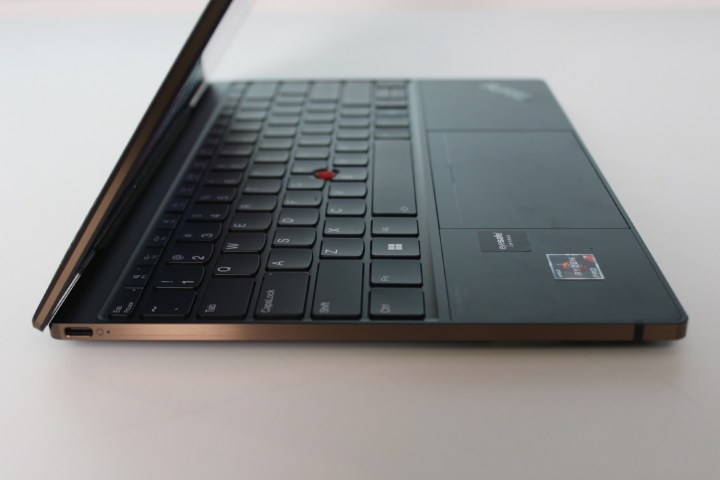
Both keyboards are comfortable to use, albeit different in their physical layout, given the Dell’s flat keycaps. We’ll call it a draw. The haptic touchpads favor the Dell, which provided a more responsive and natural feel during our testing. The ThinkPad Z13 has its TrackPoint for ThinkPad fans, which means part of its touchpad is devoted to the TrackPoint’s virtual buttons. Overall, though, both laptops provide excellent input.
Connectivity is similar, with both sporting dual Thunderbolt 4 ports, but the ThinkPad Z13 includes a 3.5mm audio jack lacking on the XPS 13 Plus. We think that gives the ThinkPad a leg up. Wireless connectivity is up-to-date on both, while the ThinkPad Z13 also offers optional 4G LTE WWAN for always-connected internet.
The ThinkPad Z13 has a higher-resolution 1080p webcam, which is much better than the XPS 13 Plus’s 720p version, while both have infrared cameras supporting Windows 11 passwordless login via facial recognition. Both also have responsive fingerprint readers as well. Dell’s is embedded in the power button, which is where we prefer to see it.
Performance
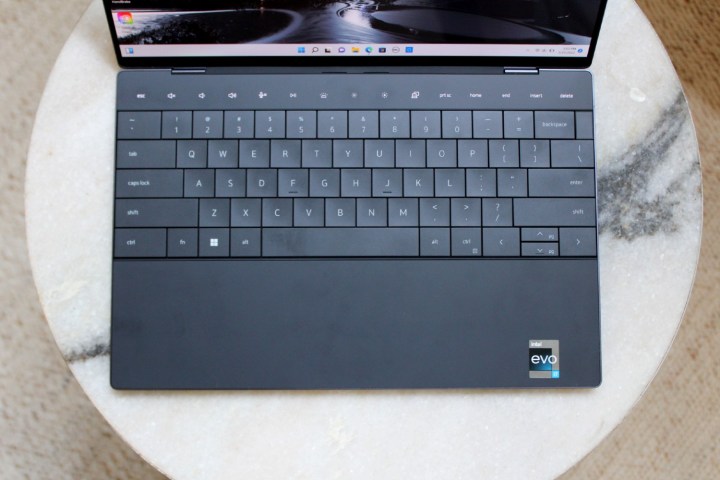
The ThinkPad Z13 we reviewed was equipped with the AMD Ryzen 7 PRO 6850 U, a 15- to 28-watt CPU with eight cores and 16 threads. That compares to the XPS 13 Plus with its 28-watt Intel Core i7-1280P, with 14 cores (six Performance and eight Efficient) and 20 threads.
The ThinkPad had a slight advantage in multi-core applications like our Handbrake test that encodes a 420MB video as H.265 and Cinebench R23, and it was much faster in the PCMark 10 Complete test that runs through a mix of productivity, media consumption, and creativity tasks. The XPS 13 Plus had to run in its performance mode to keep up.
Both are very fast productivity machines, but the ThinkPad Z13 has a slight advantage. Neither are legitimate gaming systems given their integrated graphics.
| Geekbench (single / multiple) |
Handbrake (seconds) |
Cinebench R23 (single / multiple) |
PCMark 10 Complete |
|
| Lenovo ThinkPad Z13 (Ryzen 7 PRO 6850U) |
Bal: 1,428 / 8,208 Perf: N/A |
Bal: 97 Perf: 89 |
Bal: 1,410 / 7,865 Perf: N/A |
5,812 |
| Dell XPS 13 Plus (Core i7-1280P) |
Bal: 1,316 / 8,207 Perf: N/A |
Bal: 170 Perf: 94 |
Bal: 1,311 / 6,308 Perf: 1,650 / 7,530 |
4.309 |
Display

We tested the ThinkPad Z13 with its Full HD+ IPS panel, and it was a good premium display with plenty of brightness, excellent contrast for IPS, average color width, and excellent color accuracy. It couldn’t hold a candle to the 3.5K OLED display that we tested on the XPS 13 Plus. The Dell’s display wasn’t as quick or bright, but provided incredibly wide and accurate colors and deep contrast with inky blacks.
The ThinkPad Z13’s display is fine for productivity work, but creators and media consumers will much prefer the XPS 13 Plus’s OLED display. Of course, you can always upgrade the ThinkPad Z13 to OLED, although it’s not quite as high-resolution as Dell’s offering.
| Brightness (nights) |
Contrast | sRGB gamut | AdobeRGB gamut | Accuracy DeltaE (lower is better) |
|
| Lenovo ThinkPad Z13 (IPS) |
415 | 1,220:1 | 99% | 80% | 0.84 |
| Dell XPS 13 Plus (OLED) |
386 | 386,030:1 | 100% | 99% | 0.83 |
Portability
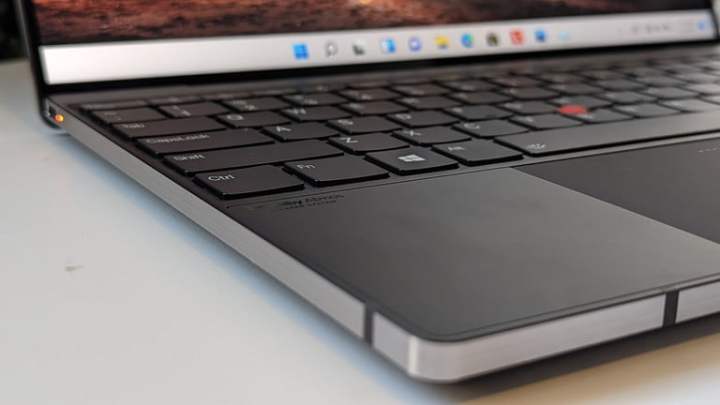
The ThinkPad Z13 and XPS 13 Plus are almost identically sized, with the ThinkPad being just a tiny bit thinner. Both are thin and light and easy to carry around.
Battery life, though, gave a huge win to the ThinkPad Z13. It lasted twice as long as the XPS 13 Plus in our web-browsing test and almost twice as long in our video test. That’s thanks to both a larger battery and the more efficient Ryzen CPU. If battery life matters to you, then the ThinkPad Z13 is the one to choose.
| Web browsing | I see | |
| Lenovo ThinkPad Z13 (Ryzen 7 PRO 6850U) |
16 hours, 34 minutes | 17 hours, 50 minutes |
| Dell XPS 13 Plus (Core i7-1280P) |
8 hours, 0 minutes | 9 hours, 20 minutes |
Excellent laptops, but the ThinkPad Z13 wins out thanks to its longevity
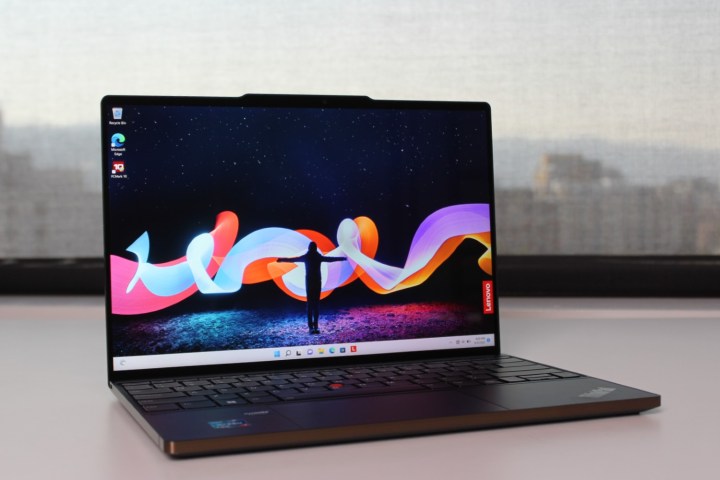
The ThinkPad Z13 and XPS 13 Plus are both excellent 13-inch laptops that can meet the needs of the most demanding productivity users. They’re both attractive, well-built, and offer fast performance.
The ThinkPad Z13 wins out in its price, which right now is hundreds lower than the XPS 13 Plus, and in its excellent battery life. Those are enough to make it the better laptop.
Editors’ Recommendations
